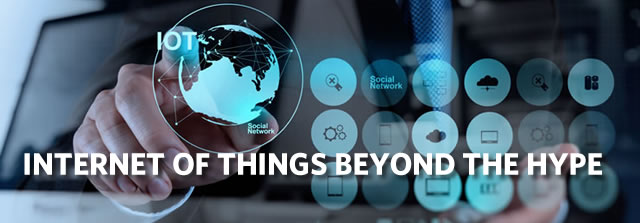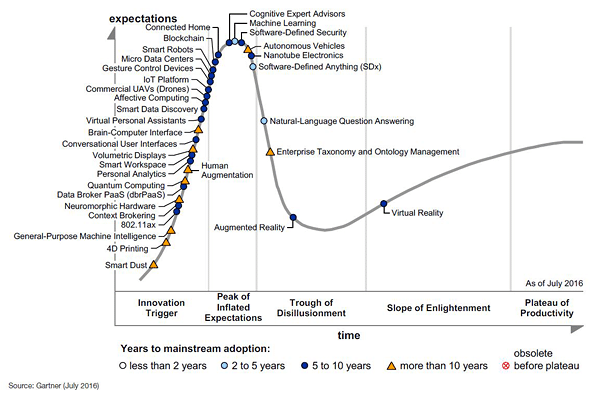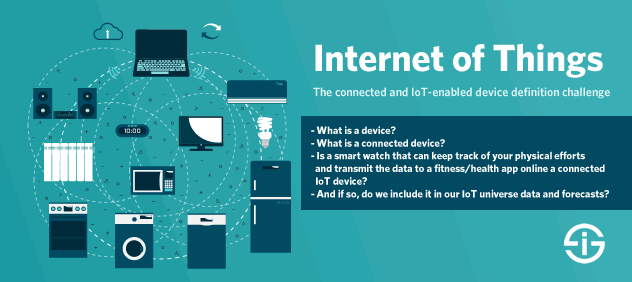If you ever looked at research regarding the state of the Internet of Things (IoT) or predictions about the growth of the number of IoT devices, applications and IoT-generated data, you probably noticed huge discrepancies in the numbers and forecasts.
Were you confused? Don’t worry, you are not alone. The matter of the fact is that no one even agrees on what the Internet of Things really means. Just look around: you won’t find a single universal definition of the Internet of Things.
As the IoT is now really omni-present in mainstream media and the marketing messages of big technology firms across the globe, it’s time to look beyond any Internet of Things hype and focus on what matters.

The difference between perceptions of urgency and the acceleration of IoT deployments
Why is it important to look beyond the Internet of Things hype aspects? First of all, smart organizations know what the Internet of Things can do for them and their customers as they move beyond pilot projects towards more scalable IoT deployments. Other research firms and consultancies have been reaching similar conclusions.
However, at the same time there is this sense of urgency which is created by many vendors in order to accelerate the transitions to the Internet of Things in several industries.
While IoT technologies and the different ways the IoT is leveraged have certainly changed enormously in recent years and while the future opportunities and growth of the Internet of Things do look good, this ‘rush’ mentality isn’t necessarily what we need. And neither is the confusion that is created if you are interested in the Internet of Things and find yourself overwhelmed by thousands of reports, and opinions, which on top often focus on messages and data that aren’t really making it clearer what the Internet of Things in practice can be for your organization or life.
Hype cycles and the definition of the Internet of Things universe
If we look at Gartner’s Hype Cycle for Emerging Technologies 2016, we see that several technologies, which traditionally are seen as part of the Internet of Things are still in the Innovation Trigger stage.
The connected home is reaching the peak of inflated expectations and IoT Platform technologies (along with blockchain and other technologies believed to enable the so-called platform revolution) still rank lower. Autonomous vehicles have past the peak of inflated expectations and move towards the through of disillusionment. And so are fog computing and edge computing, new sensor technologies and are all those consumer technologies and “smart anything” enablers. Yet, it’s in the integration of all those technologies, IoT and blockchain, IoT and AI, IoT and drones and any combination of several ones whatsoever, that the real power sits.

This is where part of the hype and battle of the numbers begin. Many technologies, many types of applications, many types of devices and many underlying enablers.
And guess what? When you stumble upon data or forecasts regarding the “Internet of Things”, as if it were a thing, it is rarely said what exactly is part of it and what not. What do we, for instance, mean if we say that the Internet of Things industry will have an estimated value of xyz Trillion Dollar market value by the year abc? And where are those auyonomous vehicles? They won’t be driving around before at least another 7-10 years, if ever.
It doesn’t stop there. What is a device? And what is a connected device?
Is a smart watch that can keep track of your physical efforts and transmit the data to a fitness/health app online a connected IoT-enabled device? And if so, do we include it in our IoT universe data and forecasts? What about the tags with microphones, motion sensors etc. in the context of IoT applicatings in farming? IoT sensors offering environmental data in a context of oil wells and other devices in industrial environments such as oil and gas (IIoT)? Devices for capacity sensing? An IoT-enabled fan in your home? Your IoT- ready TV?
The challenge of the IoT umbrella term
The list of examples goes on but the picture is clear. The term ‘Internet of Things’ is used for a gazillion of devices and applications that serve different purposes, use different technologies and really are too diverse to be able to even speak about ‘an Internet of Things’. We need to take this into account when we look at data and research on the IoT.
The challenge partially has to do with historical evolutions. From RFID and machine-to-machine technologies to a watch that sends information now and then or a “smart fan” is a big step.

With the next wave of consumer electronics (you’ll have to wait a few more years until all challenges are resolved and the consumer sees the benefit of whatever device that will make a difference, making him less wary about security and privacy) in mind, which is all about what we call IoT devices, the (definition of the) term ‘Internet of Things’ is becoming broader and more confusing.
And in the end it is becoming yet another umbrella term that is used for a myriad of reasons.
If we want to cut through the noise of the hype of data about the evolutions in the Internet of Things space and the infographics, which are filled with numbers and predictions but offer little context and serve the purposes (and thus selection criteria) of whomever made them it’s important to look at the real market drivers.
From data and sensors to action and value: the vast scope and complexity of IoT in practice
The ‘Internet of Things’ is just as good or as bad as any other term. There are ample efforts to distinguish though.
Just think about IIoT or the Industrial Internet of Things. That is pretty clear. Or the Internet of Everything, used by some vendors, although it’s less descriptive regarding the usage context and more about sending a message that it’s not about the things but about the intersection and integration of devices, data, people and processes.
If you want to understand what the Internet of Things really means for your business look at IoT use cases, the purpose, triggers and drivers of real-life applications, what you need to succeed, the buying dynamics, the context.
In business and industry applications that context is almost always one of actionable information, process automation and simply the purposes in terms of environmental benefits, cost savings, value creation and revenue growth, customer and user experience, etc.
Just putting all industries and even, within industries, all (possible) applications where we speak about the Internet of Things in one basket as we do now is a bad idea.
Consumer electronics is not logistics. Tagging cows to keep them healthier, increase milk production and smooth the calving process as in this case from Microsoft is not the same as using a soil moisture sensor, which “calculates the volumetric water content of soil according to the dialetric constant measurement and allows to control the water content of soil in order to optimize irrigation and treatments as well as to support agronomic studies” as you can read here. Yet, both are are categorized as IoT applications in “farming and agriculture”. You can add more examples from other industries (think about the really many uses of IoT in supply chains and transport and logistics).
To stay in the sphere of agriculture, you know what they say: you cannot compare apples and oranges. Yet, when it boils down to IoT, we seem to. The Internet of Things is a vast and complex reality with many facets. Business is complex and you can’t compare what’s going on in one industry or one goal or process with another. Moreover, everything evolves at different speeds with additional contextual aspects in mind (think about regulations across the globe for instance).
Asking the right questions to prevent another Internet of Things hype
So, if we write that many organizations are moving beyond the proof of concept stage across more industries as mentioned by IDC, dive deeper (that’s why these firms write reports) and ask the right questions.
The same goes for any prediction or set of data: who made it, why is it released/made and what does it tell me, on top of the nifty looking data prediction visualizations?
We had an Internet of Things hype at the beginning of this Millennium when predictions about the growth of the Internet of Things sometimes even exceeded those that are made now.
Today we see predictions with utterly different data popping up again. And in the few years we’ve been covering this renewed (and again, it IS big) attention for the accelerating IoT developments, and, yes, also hype, many of these predictions have been adapted by the organizations and sources who released them. More often than not adaptation in this case meant diminution in predicted volumes of connected devices, as an example (and we are talking in terms of billions).
Forget the Internet of Things hype: look at your business needs and the value IoT can offer in practice
Information, context, purpose, value and your individual business, industry and ecosystem. That’s what matters most when looking at the possibilities and future of the Internet of Things.
And of course getting your IoT business plan and project right, which requires a whole lot of thinking, connecting, working and looking at it holistically across divisions with security and an optimal use of the (big) data deluge which is generated through many IoT deployments as a few of the essential strategic parts.
Looking at the maturity regarding cybersecurity and information management capabilities in business overall today, these two key imperatives are harder than we might think. In a next article we will dive deeper into them.
In the meantime: we all love data and visuals but any prediction about the Internet of Things as a whole is meaningless, except when clearly detailed, put into perspective and taking into account the factors which slow down or could slow down the acceleration so many want and often are hard to foresee.
Top image: Shutterstock – Copyright: everything possible – Middle image: Shutterstock – Copyright: Shipiolik – All other images are the property of their respective mentioned owners.

